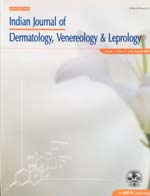
|
Indian Journal of Dermatology, Venereology and Leprology
Medknow Publications on behalf of The Indian Association of Dermatologists, Venereologists and Leprologists (IADVL)
ISSN: 0378-6323
EISSN: 0378-6323
Vol. 77, No. 5, 2011, pp. 565-570
|
 Bioline Code: dv11166
Bioline Code: dv11166
Full paper language: English
Document type: Research Article
Document available free of charge
|
|
|
Indian Journal of Dermatology, Venereology and Leprology, Vol. 77, No. 5, 2011, pp. 565-570
| en |
1064 nm Q switched Nd: YAG laser treatment of nevus of Ota: An Indian open label prospective study of 50 patients
Kar, Hemanta Kumar & Gupta, Lipy
Abstract
Background: Nevus of Ota is very common in Asians. Estimated male to female ratio
is 1:4.8. Patients seek treatment early in life due to psychological trauma and cosmetic
disfigurement. The creation of high power, short pulse Q switched lasers has recently provided
tools for considerable therapeutic advances in the treatment of dermal pigmented lesions.
Aims: To determine the efficacy and side-effect profile of Q switched Nd:YAG Laser (QSNYL)
in fifty Indian patients.
Methods: Fifty patients of nevus of Ota underwent multiple treatments
(average 5 sessions) at monthly intervals carried out over a period of 2 years with QSNYL
(Med-lite C6). Of the 50 patients, 2 were males; and the rest were females. Skin types treated
included phototype IV and V. The response after subsequent treatments was documented
through serial photographs that were taken before and after every treatment session.
Response to the treatment was graded based on quartile grading scale.
Results: Near total
improvement was seen in 8%, marked improvement in 22%, moderate improvement in 38%
and 32% patients reported less than 25% clearing of the lesion. All patients reported some
improvement. Transient postinflammatory hyperpigmentation was observed in 4 (8%) patients,
which cleared with use of sunscreens and bleaching agents within 2 months. No textural
change or scarring was observed in any patient.
Conclusions: QSNYL is an easy-to-perform
and effective treatment in cases of nevus of Ota in Indian patients with few side effects.
Keywords
Nevus of Ota, Q switched Nd:YAG laser, Indian
|
| |
© Copyright 2011 Indian Journal of Dermatology, Venereology, Leprology.
Alternative site location: http://www.ijdvl.com
|
|
